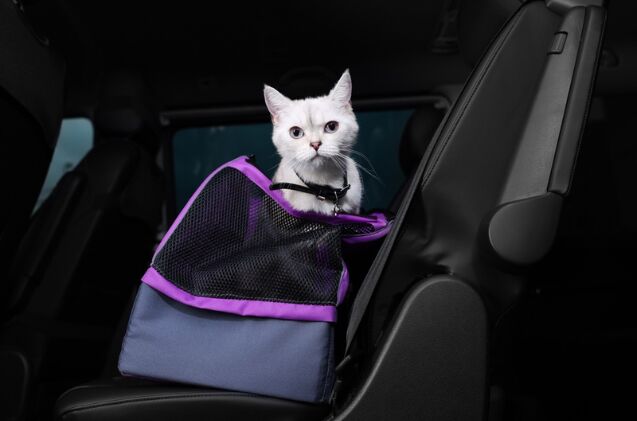Can I Travel With My Cat in the Car Safely?

If you’re planning a trip with your feline best friend, you may be experiencing both excitement and a little concern. Unlike dogs, known for their love of the car, many cats aren’t keen on a road trip. But you’ll be happy to know that you CAN help your cat learn not only to tolerate but enjoy car travel.
Let’s look at how you can travel with a cat in the car safely, including both short trips and longer road trip adventures…
How Do I Introduce My Cat to the Car?
If this is your cat’s first time in the car, you should plan to start small. Try taking your cat out into the car in your driveway and allowing them to get used to it before even putting it in motion. This is a great way to reduce anxiety and set yourself up for long-term success.
When you see that your cat is comfortable with being inside your vehicle, try introducing the next step by starting the engine. This will introduce a new sound and feeling, which can be frightening. Talk to your cat calmly and comfort them.
Continue this slow introduction by moving the vehicle slightly up and down the driveway, then going for a short drive around the block. With each step, ensure your cat is comfortable and relaxed before moving on to the next.
As tempting as it may be, don’t rush this process. Offer a lot of praise and treats to create a positive association with the vehicle and the experience as a whole.
How Long Can Cats Ride in a Car?
The time or distance your cat can successfully ride in a vehicle will depend on several factors. This includes their comfort level in the vehicle, the “amenities” you make available to them (like food, water, and a litter box), and the number of stops you make along the way.
For some cats, a 6-hour car ride is completely relaxing, and they will sleep the whole time. For others, however, even 10 minutes can feel like an eternity.
How Do You Travel Long Distances with a Cat in the Car?
Building your cat up to a short trip to the veterinarian or to visit a family member may seem easy, but what if you are getting ready to travel a much longer distance? Can your cat enjoy an extended road trip safely?
If you have a cat that is comfortable in the car, they can travel just as easily as their canine counterparts. This includes joining you for your next cross-country road trip. But there are some special considerations to make this possible.
Like you, your cat will need a comfortable place to ride. A tiny carrier may be acceptable for a quick trip across town, but you may want to consider extending their space for a longer trip. A great way to do this is to use a dog kennel. This will allow your cat to stand up, stretch their legs and readjust easily. Include some comfort items in the crate that will help them settle in, like a favorite blanket or toy. If the space is large enough, you can even include a spill-proof water dish to give them access to fresh, cool water throughout the trip.
You will also need to give your cat bathroom breaks. Travel litter boxes are a great option to ensure you have a bathroom ready and accessible. Let your cat “do their business,” and then you can either scoop it up and dispose of it like you would a dog’s waste or simply zip up the litter box to deal with when you reach your destination.
How Long Can a Cat Go Without a Litter Box?
This is the question we are asked most often by those interested in how we travel with our two cats, Pippen and Jinx. Like the question about how long your cat can ride in the car, this will also vary from cat to cat.
Some cats need to use the bathroom more frequently. This is especially true for younger kittens, senior cats, and those with medical conditions that may impact their bathroom schedule. But you also need to consider their personal preferences. In this way, cats are just like people! Some people can power through a longer drive without needing to stop, while others will need frequent bathroom breaks.
Even if your cat is a master at traveling, you should never expect them to go longer than 6 hours without access to their litter box.
6 Tips to Travel with a Cat in the Car Safely
Keep Your Cat in the Carrier
While letting your cat wander loose around your vehicle may be tempting, this could create a dangerous situation. Your cat’s carrier acts like your seatbelt, preventing them from being thrown during an accident. It also keeps them from distracting you while driving.
Consider Calming Treats
Do you have a high-energy cat? If so, staying cooped up in a carrier may drive them a little crazy. This describes our one cat Pippen perfectly. To help her relax and not get too anxious, we start longer trips with Sentry Calming Chews for Cats. These treats are formulated with ingredients like chamomile powder and melatonin to help your cat relax and enjoy the journey.
Consider Harness Training Before You Travel
Harness and leash training your cat before you hit the road allows them to step out of the vehicle with you safely. Just as you like to stretch your legs, so will your cat. If you are an outdoor travel lover, you may even want to explore a trail along the way.
But be prepared for the fact that harness and leash training isn’t something that happens overnight. There are several types of harnesses to choose from, each with its own pros and cons. There is no one-size-fits-all solution. Instead, you need to find the best option for your cat. We use a different harness for each of our cats as they have different body types.
Line Your Cat’s Carrier with Pee Pads
Even if you have carefully planned bathroom breaks to work with your cat’s regular schedule, no one wants to be stuck cleaning a mess on the road. Before getting your cat situated, line the bottom of their carrier with pee pads like those used when potty training a puppy. On top of these pads, you can place a towel, blanket, or cat bed to make it more comfortable.
If there is an accident or your cat suffers from motion sickness and gets sick, this will keep everything contained for easy cleanup. Just be sure to pack some extras to replace them with.
Stick to Your Cat’s Normal Litter
When filling your travel litter box, stick with the same litter that you use in the litter box at home. Anytime you change your cat’s litter, you run the risk that they may not like the new product or are reluctant to use it. This could be because it smells different or feels different on their paws. By sticking with the litter they know and like, you increase the likelihood that they will use their travel box without any problems.
Talk to Your Veterinarian About Sedatives
If you absolutely must travel with your cat, but they aren’t comfortable in the car, your vet may be able to help make the trip less stressful. There are several different medications that they may be able to prescribe to calm and relax your cat throughout the duration of the trip.
I don’t recommend this for recreational travel – if your cat is that uncomfortable in the car, they are likely happier at home or with a pet sitter. But some situations can’t be avoided, like if you are moving.
Book your appointment early enough to try the medication at home before relying on it for travel. This will allow you to monitor how your cat reacts, address any concerns, and work with your vet to ensure you have the optimal dosage before you hit the road.
Final Thoughts – Car Travel with Your Cat
Your cat can make a great travel buddy, but there is a little planning and preparation involved to ensure that you will both enjoy and safe and fun trip. Set up a carrier for your cat with their favorite blanket or bed. This will keep them comfortable and safely contained. If this is your cat’s first trip, introduce the vehicle slowly and work up from there. If you are short on time and have to transport a cat that is uncomfortable in the vehicle, such as for a pending move, consider contacting your veterinarian to discuss the option of sedatives.

Britt Kascjak is a proud pet mom, sharing her heart (and her home) with her “pack” which includes her husband John, their 2 dogs – Lucifer and Willow – and their 2 cats – Pippen and Jinx. She has been active in the animal rescue community for over 15 years, volunteering, fostering and advocating for organizations across Canada and the US. In her free time, she enjoys traveling around the country camping, hiking, and canoeing with her pets.
More by Britt
























